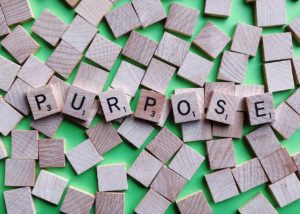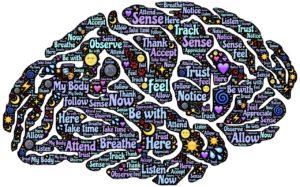 Photo Credit: Buro Millennial-Pexels
Photo Credit: Buro Millennial-Pexels So much is beyond our control in this life. Fortunately, intention is not one of them.
Where we try to point our mind is always under our purview, whether in the form of goals, objectives, plans, mantras and more. I emphasize the word “try” because our minds naturally monkey about, taking us in different directions in response to the many and continual pulls on our attention. These stimuli can be internal (a sensation or thought) or external, ranging from something as simple as a sound or sight, to the more complex demands both at home and work.
With the responsibilities of modern living, along with the ever-growing digital onslaught, it’s no wonder many often feel overwhelmed and scattered. (To this last point, chomp on this: studies show that digital activity is growing exponentially, with 90% of the world’s existing data being created in the last two years alone!)[1]
If we don’t consciously choose what to pay attention to, the choice gets made for us, often leaving us depleted, dissatisfied, distracted and inefficient.
What is attention?
In the field of psychology, the term “attention” has been variably defined. Generally speaking, it refers to the cognitive process of concentration – selectively focusing on some stimuli, while tuning out others. Attention-deficit refers to impairments in this ability to focus, with a diagnosis of attention deficit disorder (ADD or ADHD) being given when clinical criteria from the American Psychiatric Association’s Diagnostic and Statistical Manual (DSM) are met.[2]
What is intention?

In contrast to attention, “intention” is a broader concept that refers to the overarching motivation or meaning that’s driving cognition and/or behavior. Sometimes we’re aware of our intentions and sometimes not. Similarly, intentions can fall along a continuum of more wholesome[3], like giving without expectation of return, to less so, being propelled more by ego (e.g., approval seeking and competition).
Why is attention and intention so important?
Both what we pay attention to and how we do it shapes our experience of life itself.
If we devote many hours per day reading the news for example, we’ll probably experience a fair bit of doom and gloom. On the other hand, if we stay informed, but allocate most of our time to engagement with constructive endeavors – connecting with others, tending to our health, completing necessary tasks at work and home – we’re more apt to feel fairly positive and satisfied at the end of the day, despite what’s playing out on the global stage.[4]
Similarly, if we have frequent contact with people who continually voice their own unhappiness, that may rub off on us as well. Without enough awareness, we may fall into the reactivity trap of buying into their pessimism, or judging and pushing them away. If, however, we can relate to our interaction with the openness and compassion of mindfulness, we’re more apt to act skillfully, perhaps by showing empathy, offering some tangible assistance or setting healthy boundaries.
This speaks to the piece of “how” we pay attention. Reflecting on and identifying our deeper intentions is powerful because it provides a map from which we can continually return, to give us guidance on how to be our best, fully human and effectual selves.

Unfortunately, the concept of intention can sometimes get a bad rap. Connotations of new age “woo” à la The Secret misrepresent the true, grounded and non-magical power of intention: that how (and to what) we pay attention can actually change our brain. This is sometimes described with the saying, “cells that fire together, wire together” – a reference to Hebbian theory, also known as associative learning[5].
For example, if at the end of each day we consciously review the things we’re thankful for, we’re more apt to experience greater wellbeing[6], viewing life as having an ample dose of generosity. In contrast, if we mainly pay attention to what’s missing, then we’ll reinforce more of a scarcity mentality[7].
Like anything, the more we practice, the better, making it easier to tap into positive states. With the aforementioned example related to gratitude, we’re also developing an associative evening routine: when the sun goes down, we may start to experience munificence without even trying.
In other words, what we focus on grows: the more time we spend engaging our minds in a certain way, reinforcing desired thoughts and behaviors, the stronger those neural pathways, or habits, become.
“Change the way you look at things and the things you look at change.” – Wayne Dyer
The process of associative learning is happening naturally all the time, but the power of deliberate intention helps bring this under more of our control, giving us greater agency to make changes and accomplish what’s important.
Granted, our personal history, biology and current environment all create tendencies, leading to more and less focused, or aware, times. If prone to anxiety, for example, we may easily get caught in loops of procrastination, losing sight of our original focus or intention. And, since we all have a built-in negativity bias, it often takes more effort in general to stay on course in a creative way and to work against our inclination to focus on what isn’t going (or may not go) well as a way of protecting ourselves. Intention is one way to work with all of this.
Intention is not about the supernatural, where you wish for something and voila, it suddenly appears. Intention is about choosing, over and over again, where to direct your precious attention. It’s a straightforward concept, yet often not so easy to implement, perhaps due to its simplicity and subtlety (which mask its power and requisite effort), along with our our propensity to get sidetracked. But, keep in mind that if you don’t choose where to put your attention, the unremitting worldly winds will make the choice for you, often leading to a sense of overwhelm and dissatisfaction.
Working with intention

Things like TV and the “inter-webs”[8] are designed to hijack our attention. While these and other forms of entertainment and learning have their utility, if not feeling centered, we’re vulnerable to being swept away into a the black hole of media (if you’ve watched comedic show Portlandia’s ‘One Moore Episode’, you know what I mean). Similar to the HALT concept that makes one more susceptible to relapse; when Hungry, Angry, Lonely, or Tired, we’re far more prone to fall into bad habits, losing track of our original, deeper intent. “Stress,” generally speaking, when too intense or prolonged, can also do the same. So, set yourself up for success by regularly managing your stress and being strategic about your schedule whenever possible (e.g., if you’re a morning or evening person, engage in your most demanding tasks then).
It can be enjoyable and insightful to experiment with setting an intention for one whole day and then evaluating the results (keeping in mind that when we pair ‘joy’ with ‘work’ by making a project more fun, that’s creating a new, positive neural network!). For example, your daily intention could be to slow down to relax or speed up to increase efficiency, depending on your particular challenges as a person. Or, it could be to eat only whole foods, eliminating all processed ones. Or, if you want to build social skills, it could be about making an effort to smile at every person you see that day, something that recognizes the benefits of micro-moments of connection. At the end of the day, notice how you feel and ask yourself what you learned.
If you find yourself struggling to make your intentions materialize, no need to let judgment or frustration send you further off track. Just like in meditation, when our mind goes astray, our job is to simply return to the object of attention. Just get back on the horse and begin again by returning to what’s important; in this case, our intention. Maybe it’s to complete a project; to be more compassionate; to listen better; to engage in self-care; to participate in a political movement; or to live more in the present. Whatever it is, give it your all. As a favorite elementary school teacher used to say, “practice makes progress!”
And, if you’re uncertain about your intentions, carve out some regular time to reflect on these, perhaps by journaling, reading, meditating or talking with others. Popular spiritual teacher and psychologist Tara Brach, PhD., has over 20 blog posts and guided meditations on intention that may be of help here.
In Conclusion
“Attention” is one of our super powers as human beings. Channeled properly, it can move mountains. So, use it wisely! Make a conscious effort to choose how and what you’d like to develop – in your personhood, relationships, vocation and community. Identifying and continuously returning to intention is one way to do so.
References:
[1] Source: http://comsense.consulting/wp-content/uploads/2017/03/10_Key_Marketing_Trends_for_2017_and_Ideas_for_Exceeding_Customer_Expectations.pdf. Note: “data” includes, but may not be limited to “online activity.”
[2] Source: https://www.cdc.gov/ncbddd/adhd/diagnosis.html
[3] Source: https://media.rickhanson.net/home/files/WholesomeIntentions.pdf
[4] Note: this isn’t to make a case for denial, but more to remind us that we have power over where we put our attention.
[5] Source: https://en.wikipedia.org/wiki/Hebbian_theory
[6] Source: https://healthypsych.com/want-to-be-happier-practice-gratitude/
[7] Note: there’s value in paying attention to and learning from pain and suffering, from what is considered more “negative.” But, it’s important to have a balance and since we all have a negativity bias, it takes more conscious effort to notice the positive.
[8] Source: I first heard Rachel Maddow use this term of ‘interwebs’ in reference to the Internet. Not sure if she coined it or somebody else.
Further Resources:
Over 20 blog posts and guided meditations on intention, from Buddhist teacher and psychologist, Tara Brach: https://www.tarabrach.com/intention/.
10 page overview of “Wholesome Intentions” by Neuropsychologist, Rick Hanson: https://media.rickhanson.net/home/files/WholesomeIntentions.pdf.
The Heart’s Intention, excerpt from Jack Kornfield’s After the Ecstasy, the Laundry.

Leave a reply
You must be logged in to post a comment.